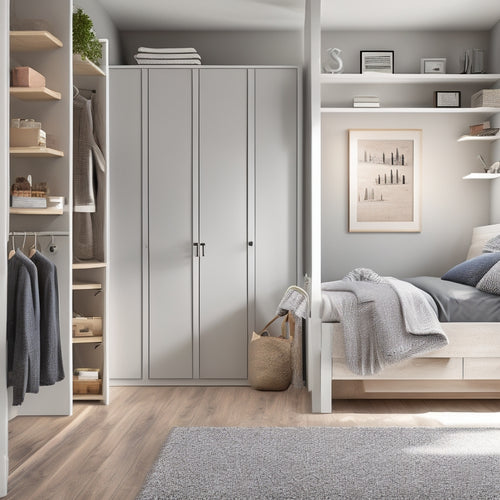
Declutter Your Home Like a Pro
Share
To declutter your home like a pro, focus on high-impact areas that affect your daily routine, such as the bedroom, bathroom, and living room. A tidy space can boost your daily routine and overall well-being. Next, tackle kitchen chaos by decluttering meal prep and cooking areas, and implement clever storage solutions to maintain organization. Conquer cluttered spaces like closets and pantries, and establish routines to prevent clutter from creeping back in. By streamlining your storage and establishing maintenance habits, you'll be well on your way to a clutter-free home that stays that way. Now, take the next step to achieving a perfectly organized space.
Key Takeaways
• Start with high-impact areas like the bedroom, bathroom, and living room to maximize visual and functional improvement.
• Declutter and organize kitchen essentials like spices, Tupperware, and cleaning products to boost meal prep and cooking efficiency.
• Implement clever storage solutions, such as stackable bins, shelves, and hooks, to optimize space and reduce clutter.
• Establish routines and schedules to maintain organization and prevent clutter from creeping back in over time.
• Review and adjust organizational systems regularly to ensure they continue to meet your changing needs and preferences.
Start With High-Impact Areas
When decluttering your home, it is essential to start with high-impact areas that have the greatest visual and functional impact on your daily life. Begin with bedroom decluttering and closet organization, where a tidy space can boost your morning routine.
Next, tackle the bathroom overhaul, where a clutter-free zone can make your daily grooming more efficient. Don't forget the living room revamp, where an organized space can become the heart of your social gatherings.
Tame the Kitchen Chaos
Having tackled the high-impact areas, it's time to turn your attention to the kitchen, a space that can quickly become overwhelmed by clutter and disorganization, negatively impacting meal prep and cooking efficiency.
A cluttered kitchen can be a recipe for disaster, but fear not! With a few simple steps, you can tame the chaos and get back to cooking up a storm.
-
Conduct a spice organization overhaul, ditching expired or duplicates and categorizing the rest by type or frequency of use.
-
Purge your Tupperware collection, tossing any containers with missing lids or those that have seen better days.
-
Overhaul your cleaning product stash, tossing old or ineffective products and organizing the rest by category or frequency of use.
- Consider donating unused appliances or gadgets to free up valuable counter and storage space.
Conquer Cluttered Spaces
Cluttered spaces, often hidden from view, can harbor a staggering amount of disorganization, making it essential to tackle these areas to achieve a truly decluttered home.
Start by conquering your closet, where clothes, shoes, and accessories can quickly accumulate. Implement a closet organization system that works for you, and purge items that no longer fit or spark joy.
Next, move on to bedroom decluttering, tackling nightstands, dressers, and under-bed storage.
Don't forget to tackle bathroom organization, where toiletries, towels, and cleaning supplies can become cluttered.
Finally, give your pantry a thorough cleanup, sorting through expired or unused food items and reorganizing your storage space.
Streamline Your Storage
Effective storage solutions are crucial for maintaining a decluttered home, and tackling these often-overlooked areas is essential for streamlining your storage and keeping your belongings organized.
By implementing clever storage solutions and decluttering hacks, you can maximize your space and reduce clutter. Here are some expert tips to get you started:
-
Use stackable bins and baskets to store items like linens, toys, and cleaning supplies, keeping them out of sight and freeing up valuable floor space.
-
Install shelves and hooks to hang items like bikes, bags, and accessories, making the most of your walls and ceilings.
-
Utilize hidden storage compartments, such as under-bed storage or hollowed-out books with secret compartments, to stash valuable or sensitive items.
- Implement a 'one in, one out' policy to prevent clutter from building up in the future, ensuring your newly organized space stays that way.
Finishing Touches and Maintenance
With your newly decluttered and organized space in place, the final step is to establish routines and habits that will maintain this sense of order and prevent clutter from creeping back in.
To guarantee long-term organization, implement preventative measures such as regular deep cleaning and maintenance tips like scheduling weekly tidying sessions.
Set reminders to review and adjust your organizational systems every few months to prevent clutter buildup.
By incorporating these habits into your daily routine, you'll be able to enjoy your newly organized space for years to come.
Frequently Asked Questions
How Do I Decide What Items to Keep and What to Throw Away?
Imagine standing at the crossroads of sentiment, where memories and emotions collide with the harsh reality of clutter.
To navigate this juncture, ask yourself: does this item spark joy or serve a purpose? Be ruthless – the nostalgia trap can lead to Decision Fatigue.
Create a 'maybe' box for items that evoke sentiment, and revisit them later with a clearer mind.
What Is the Best Way to Organize Cords and Adapters?
Cord Management 101: Taming the Tangled Beast!
Effective cord organization starts with Cable Labeling - identify each cord's purpose and label it accordingly.
Use cable ties or zip strips to group related cords together, and store them in a designated container or cord organizer.
Consider a cord reel or over-under cable management system for larger collections.
Can I Donate Old or Broken Items to Charity?
Before donating old or broken items to charity, it's important to explore the truth: not all items are accepted, and some may even be harmful to the environment. Researching charity organizations and utilizing charity research tools can help determine what's acceptable.
Donating functional items can provide tax deduction benefits, but it's vital to obtain receipts and follow IRS guidelines.
How Often Should I Declutter and Organize My Home?
Maintaining a clutter-free home requires a balance of regular habits and periodic refreshes. Aim to establish daily habits, such as tidying up for 10 minutes each morning, to keep clutter at bay.
Schedule a seasonal refresh every 3-4 months to tackle deeper organizational projects, like reorganizing closets or decluttering storage areas.
This combination of daily habits and seasonal refreshes will help keep your home organized and clutter-free throughout the year.
Are There Any Eco-Friendly Ways to Dispose of Hazardous Waste?
'One man's trash is another man's treasure' - but what about hazardous waste? When it comes to eco-friendly disposal, proper recycling is crucial. Partner with local community involvement initiatives that host hazardous waste collection events or facilities.
Guarantee responsible disposal of items like batteries, electronics, and chemicals. Don't let toxins pollute our planet - take the extra step to recycle right!
Related Posts
-

7 Clever Hacks for Small Bedroom Storage
You're about to discover the secret to revealing generous storage in even the smallest of bedrooms. Start by maximizi...
-

Streamline Your Space: Decluttering Strategies for Minimalists
You're wasting time and energy maneuvering through cluttered spaces, which is why streamlining your space is essentia...

